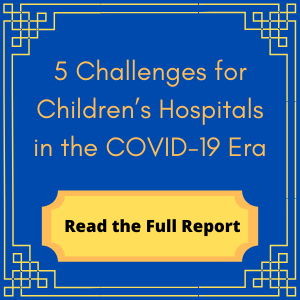We’ve all heard that COVID-19 generally does not affect children as much as it affects adults. Which means children’s hospitals aren’t as affected by the pandemic as adult acute care hospitals are, right? Wrong.
The COVID-19 pandemic has upended the good work being done at pediatric institutions across the country. In this blog post, we’ll examine some of the challenges children’s hospitals are facing, and see how healthcare analytics can help out.
Consolidation in pediatric care
While children’s hospitals are not experiencing the same influx of COVID-19 patients that adult acute care hospitals are experiencing, they are suffering from ripple effects.
One important change is that children’s hospitals have been involved in consolidating pediatric care. Typically, about 50% of hospitalized children are cared for in 2,000 adult facilities across the country. But due to COVID-19, acute care hospitals have needed to make these beds available for adult patients, while also ensuring the safety of medically fragile children.
To help with this effort, the Children’s Hospital Association (CHA) has recommended consolidating pediatric care by moving children, and in some cases, young adults, from acute care facilities into children’s hospitals, if possible.
Deferring elective procedures
 Like acute care hospitals, children’s hospitals have had to defer many elective procedures to ensure the safety of patients, families, physicians, and other hospital staff. This also helps them manage the capacity surge as acute care hospitals fill with COVID-19 patients.
Like acute care hospitals, children’s hospitals have had to defer many elective procedures to ensure the safety of patients, families, physicians, and other hospital staff. This also helps them manage the capacity surge as acute care hospitals fill with COVID-19 patients.
Deferring these procedures has resulted in significant revenue losses for children’s hospitals, and these hospitals will have to apply for public health emergency funding as provided in the CARES Act that was passed by Congress.
Increased patient protocols
During the COVID-19 threat, it’s more important than ever for children’s hospitals to understand who is coming into the facility and what their health status is. With the care of medically fragile children needing to continue, it’s imperative that these children and their healthcare providers do not get sick.
Many hospitals have changed their patient and visitor protocols since early 2020 due to the COVID-19 threat. For example, Boston Children’s Hospital screens all staff, patients, and family members upon arrival at the hospital and has limited the number of patient visitors to two caregivers.
These increased protocols cost children’s hospitals time and, as a result, money.
How analytics can help
Analytics can help children’s hospitals deal with these challenges in myriad ways:
- Capacity management: Analytics can help hospitals determine what space they have available to patients and what space they might be able to convert into additional beds. It also enables them to see up-to-date census data and understand where in the hospitals patients and staff are located.
- Financial tracking: Analytics can help hospitals track finances and missed revenue opportunities, and enable users to quickly visualize that information and drill down into the details if they need to. In addition, as children’s hospitals apply for funding provided by the CARES Act, analytics will enable them to organize their information and have it readily available to ensure as smooth of a reimbursement process as possible.
- Organizing policies and resources: Analytics solutions can help children’s hospitals organize their policies and resources so data on patients and caregivers is easily accessible to staff.
- Staffing: Children’s hospitals can integrate staffing data into their analytics solutions so they can understand productivity, absent or sick staff, and where their staff is located within the hospital.
Conclusion
The COVID-19 pandemic is affecting hospitals around the globe, though it is having some differing impacts between children’s hospitals and acute care hospitals. Analytics can help pediatric institutions plan for capacity during the pandemic, track finances, organize policies, and monitor staffing.
If you’d like to read more on these challenges and others that children’s hospitals are facing during the COVID-19 pandemic, read our white paper, “5 Challenges for Children’s Hospitals in the COVID-19 Era.”
- Navigating the Future: Trends in Wine Tasting Rooms - July 16, 2024
- Why You’ll Want to Attend DIUC24 - June 20, 2024
- The Role of Technology in Solving Nursing Challenges - May 6, 2024



